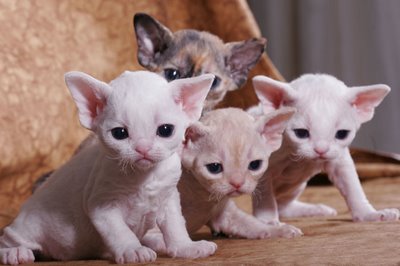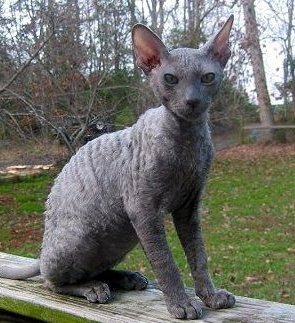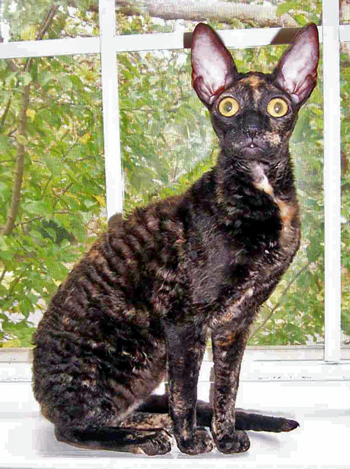



|
Cornish Rex Description
The Cornish Rex is similar to the Devon Rex in body type but different in coat; it is the Gene 1 variation of the Rex gene and the originally discovered breed. This breed is a study in curves, most noticeably in the coat which should be in curls that remind the owner of a washboard. The Cornish Rex has a coat that is short and noted for its softness as it completely lacks guard hairs; it is the result of a genetic mutation. The hair should be in a tight marcel wave that extends from the top of the head to the end of the tail and around the sides. The breed is available in seven coat categories with more than 70 colors.
Cornish Rex Temperament
The Cornish Rex is a very active, family oriented cat. They play in three dimensions and need vertical climbing space as well as plenty of running room. They are inventive in their play and love games like catch or fetch, even throwing their own toys across the room just to chase after them. They are a good breed for those with mild allergies as their coat does not shed often - however, those with serious allergies should be cautious as they still have both dander and the enzyme Fel d1 which is responsible for most feline allergies. Often nicknamed 'velcro' cats by their owners, they want to be as close to their people as possible. You will always find them with their noses right in the middle of the action because that is where the people are. They are ideal for a busy household, they love attention but will not pine for you if you are not home.
Cornish Rex Care
The Cornish Rex is a very sturdy breed thanks to early outcrossing by American breeders. They require little grooming but have a legendary appetite that helps to feed their high energy level. Interestingly, Cornish Rex's are also known for picking a favorite vegetable. They are very long lived, it is not uncommon for cats of this breed to live into their 20's.
Cornish Rex History
Named for its location of origin, the first Cornish Rex was discovered in a litter of barn cats in Cornwall, England in about 1950. A Mrs. Ennismore became attached to a kitten in a litter of domestic shorthairs, he was thinner, his coat curlier and so she chose to adopt him and took him to her local veterinarian to be neutered. Thankfully for the breed, the vet recognized that the little kitten, named Kallibunker, was something special and advised Mrs. Ennismore to consult a geneticist. It was decided that the cause of Kallibunkers' strange coat was the result of a spontaneous genetic mutation and the geneticist recommended that Kallibunker be bred back to his mother to see if the look could be replicated. Two of the three resulting kittens were born with the tight, curly coat and lanky body of their father. Further testing the state of the gene, Kallibunker was then bred to Burmese, Siamese, and other domestic shorthairs and it was discovered that the gene was recessive.
Mrs. Ennismore was a breeder of Rex rabbits and noted the similarity in coat, choosing to name the new cat breed Rex. Within a few years, Kallibunker and his new breed had caught the eye of the world when LIFE magazine published an article about them. American breeders were captivated and began their own breeding programs that included outcrosses to a number of other breeds and almost led to a loss of type. This outcrossing, however, was an unsuspected blessing as the breed was almost completely exterminated in the UK. Mrs. Ennismore found herself in an increasingly difficult financial situation and was forced to destroy the majority of her cats. This reduced the number of breeding males in the UK to two. A medical accident caused the castration of one of these males, leaving the UK with one Cornish Rex male.
The continuation of the Cornish Rex fell to breeders in America and they continued outcrosses which brought in a wide variety of colors and patterns. The Cornish Rex was accepted into the CFA in 1964. Outcrossing is no longer allowed as the gene pool is considered large enough to sustain the breed.
|